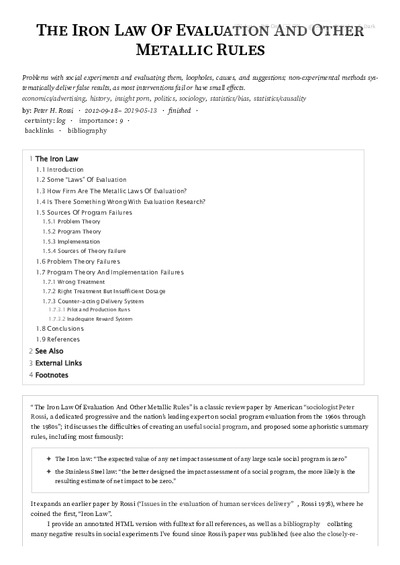 Diese Seite wurde seit 3 Jahren inhaltlich nicht mehr aktualisiert.
Unter Umständen ist sie nicht mehr aktuell.
Diese Seite wurde seit 3 Jahren inhaltlich nicht mehr aktualisiert.
Unter Umständen ist sie nicht mehr aktuell.
 Zusammenfassungen
Zusammenfassungen
Evaluations of social programs have a long history, as history goes in the social sciences, but it has been only in the last two decades that evaluation has come close to becoming a routine activity that is a functioning part of the policy formation process. Evaluation research has become an activity that no agency administering social programs can do without and still retain a reputation as modern and up to date. In academia, evaluation research has infiltrated into most social science departments as an integral constituent of curricula. In short, evaluation has become institutionalized.
There are many benefits to social programs and to the social sciences from the institutionalization of evaluation research. Among the more important benefits has been a considerable increase in knowledge concerning social problems and about how social programs work (and do not [pg4] work). Along with these benefits, however, there have also been attached some losses. For those concerned with the improvement of the lot of disadvantaged persons, families and social groups, the resulting knowledge has provided the bases for both pessimism and optimism. On the pessimistic side, we have learned that designing successful programs is a difficult task that is not easily or often accomplished. On the optimistic side, we have learned more and more about the kinds of programs that can be successfully designed and implemented. Knowledge derived from evaluations is beginning to guide our judgments concerning what is feasible and how to reach those feasible goals.
To draw some important implications from this knowledge about the workings of social programs is the objective of this paper. The first step is to formulate a set of “laws” that summarize the major trends in evaluation findings. Next, a set of explanations are provided for those overall findings. Finally, we explore the consequences for applied social science activities that flow from our new knowledge of social programs.
Von Peter Rossi im Text The Iron Law Of Evaluation And Other Metallic Rules (1987) There are many benefits to social programs and to the social sciences from the institutionalization of evaluation research. Among the more important benefits has been a considerable increase in knowledge concerning social problems and about how social programs work (and do not [pg4] work). Along with these benefits, however, there have also been attached some losses. For those concerned with the improvement of the lot of disadvantaged persons, families and social groups, the resulting knowledge has provided the bases for both pessimism and optimism. On the pessimistic side, we have learned that designing successful programs is a difficult task that is not easily or often accomplished. On the optimistic side, we have learned more and more about the kinds of programs that can be successfully designed and implemented. Knowledge derived from evaluations is beginning to guide our judgments concerning what is feasible and how to reach those feasible goals.
To draw some important implications from this knowledge about the workings of social programs is the objective of this paper. The first step is to formulate a set of “laws” that summarize the major trends in evaluation findings. Next, a set of explanations are provided for those overall findings. Finally, we explore the consequences for applied social science activities that flow from our new knowledge of social programs.
 Dieser wissenschaftliche Zeitschriftenartikel erwähnt ...
Dieser wissenschaftliche Zeitschriftenartikel erwähnt ...
 Zitationsgraph (Beta-Test mit vis.js)
Zitationsgraph (Beta-Test mit vis.js)
 1 Erwähnungen
1 Erwähnungen 
- Vom E-Learning zur Digitalisierung - Mythen, Realitäten, Perspektiven (Reinhard Bauer, Jörg Hafer, Sandra Hofhues, Mandy Schiefner, Anne Thillosen, Benno Volk, Klaus Wannemacher) (2020)


- Digitalisierung der Hochschullehre: Was wissen wir wirklich? (Jörn Loviscach)

- Digitalisierung der Hochschullehre: Was wissen wir wirklich? (Jörn Loviscach)
 Volltext dieses Dokuments
Volltext dieses Dokuments
 |  The Iron Law Of Evaluation And Other Metallic Rules: Artikel als Volltext ( The Iron Law Of Evaluation And Other Metallic Rules: Artikel als Volltext ( : :  , 3493 kByte; , 3493 kByte;  : :  ) ) |
 Anderswo suchen
Anderswo suchen 
 Beat und dieser wissenschaftliche Zeitschriftenartikel
Beat und dieser wissenschaftliche Zeitschriftenartikel
Beat hat Dieser wissenschaftliche Zeitschriftenartikel während seiner Zeit am Institut für Medien und Schule (IMS) ins Biblionetz aufgenommen. Beat besitzt kein physisches, aber ein digitales Exemplar. Eine digitale Version ist auf dem Internet verfügbar (s.o.). Aufgrund der wenigen Einträge im Biblionetz scheint er es nicht wirklich gelesen zu haben. Es gibt bisher auch nur wenige Objekte im Biblionetz, die dieses Werk zitieren.











 The Iron Law of Evaluation
The Iron Law of Evaluation The Stainless Steel Law of Evaluation
The Stainless Steel Law of Evaluation The Zinc Law of Evaluation
The Zinc Law of Evaluation Wissenschaft
Wissenschaft Biblionetz-History
Biblionetz-History